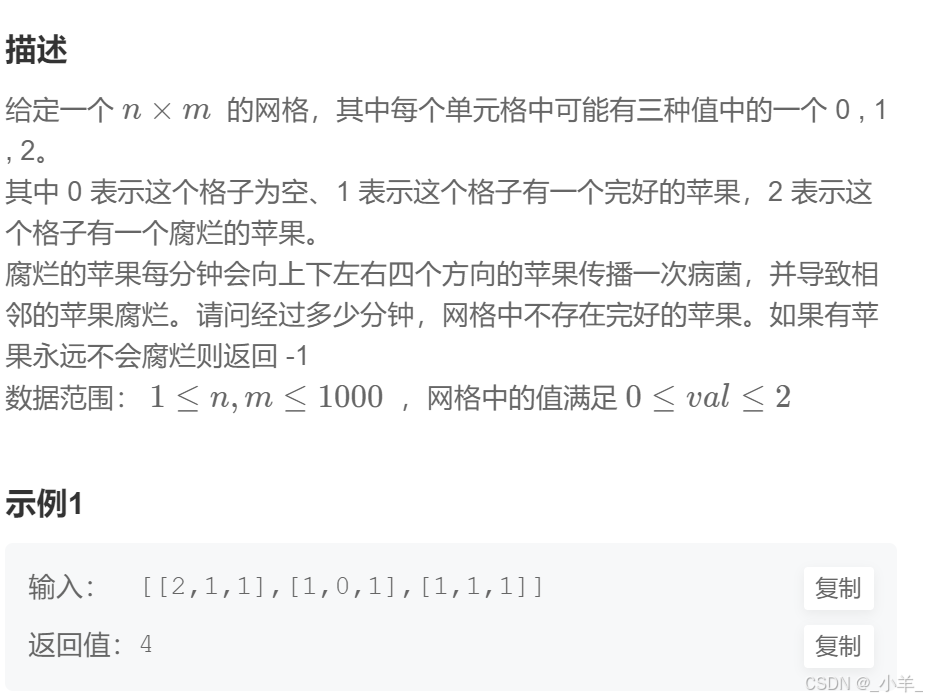算法DFSBFS拓扑排序

目录
【算法】DFS、BFS、拓扑排序

⭐️个人主页:
⭐️所属专栏:
很荣幸您能阅读我的文章,诚请评论指点,欢迎欢迎 ~

持续更新中…
1、DFS
class Solution
{
int dx[4] = {1, -1, 0, 0};
int dy[4] = {0, 0, 1, -1};
bool check[101][101] = {};// 标记数组,防止上下左右找的时候重复遍历
int m, n;
public:
bool exist(vector<string>& board, string word)
{
m = board.size(), n = board[0].size();
for (int i = 0; i < m; i++)
for (int j = 0; j <n; j++)
if (board[i][j] == word[0])
{
check[i][j] = true;
// 找到第一个字符了,开始找下一个字符
if (dfs(board, word, i, j, 1)) return true;
check[i][j] = false;
}
return false;
}
bool dfs(vector<string>& board, string& word, int i, int j, int pos)
{
// 找到单词结尾就返回
if (pos == word.size()) return true;
for (int k = 0; k < 4; k++)
{
int x = i + dx[k], y = j + dy[k];
if (x >= 0 && x < m && y >= 0 && y < n && !check[x][y] && board[x][y] == word[pos])
{
check[x][y] = true;
if (dfs(board, word, x, y, pos + 1)) return true;
check[x][y] = false;
}
}
// 如果走到这里说明没有进递归,也就是四个方位都没找到字符
return false;
}
};2、BFS
通常利用队列
first in first out的特点,统计出每层的q.size()以遍历每一层。
N 叉树的层序遍历

class Solution {
public:
vector<vector<int>> levelOrder(Node* root) {
vector<vector<int>> ret;
if (root == nullptr) return ret;
queue<Node*> q;
q.push(root);
while (!q.empty())
{
vector<int> tmp;
int size = q.size();
while (size--)
{
tmp.push_back(q.front()->val);
for (auto e : q.front()->children)
{
q.push(e);
}
q.pop(); // 利用父节点把子节点全部插入队列后再删除父节点
}
ret.push_back(tmp);
}
return ret;
}
};二叉树的锯齿形层序遍历

遇到二叉树的题一定注意判断 有没有左右子节点 ,不然很容易对空节点解引用。
class Solution {
public:
vector<vector<int>> zigzagLevelOrder(TreeNode* root) {
vector<vector<int>> ret;
if (root == nullptr) return ret;
queue<TreeNode*> q;
q.push(root);
int flag = 1;
while (!q.empty())
{
int size = q.size();
vector<int> tmp;
while (size--)
{
auto t = q.front();
tmp.push_back(t->val);
if (t->left) q.push(t->left);
if (t->right) q.push(t->right);
q.pop();
}
flag *= -1;
if (flag > 0) reverse(tmp.begin(), tmp.end());
ret.push_back(tmp);
}
return ret;
}
};二叉树最大宽度
3、多源BFS
腐烂的苹果

class Solution {
int dx[4] = {1, -1, 0, 0}, dy[4] = {0, 0, 1, -1};
queue<pair<int, int>> q;
int m, n, ret = 0;
bool vis[1001][1001] = {};
public:
int rotApple(vector<vector<int> >& grid) {
m = grid.size(), n = grid[0].size();
for (int i = 0; i < m; i++)
for (int j = 0; j < n; j++)
if(grid[i][j] == 2) q.push({i, j});
while (!q.empty())
{
int sz = q.size();
ret++;
while (sz--)
{
auto [a, b] = q.front();
q.pop();
for (int k = 0; k < 4; k++)
{
int x = a + dx[k], y = b + dy[k];
if (x >= 0 && x < m && y >= 0 && y < n
&& !vis[x][y] && grid[x][y] == 1)
{
vis[x][y] = true;
q.push({x, y});
}
}
}
}
for (int i = 0; i < m; i++)
for (int j = 0; j < n; j++)
if (grid[i][j] == 1 && !vis[i][j])
return -1;
return ret - 1;
}
};4、拓扑排序
本篇文章的分享就到这里了,如果您觉得在本文有所收获,还请留下您的三连支持哦~
